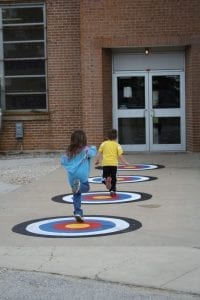Redlands Daily Facts
August 2004
In 1973, an idea struck Los Angeles educator Melinda Bossenmeyer after years of being a teacher and a principal within the Riverside County Department of Education.
“I noticed that some kids didn’t have many of the skills necessary to solve problems on the school playground,” she says. Also, “Kids learn to play different games by a variety of different rules, so they are often playing games on the playground with different sets of rules.”
“Often,” she adds, “there too few playground games on California school playgrounds. But schools send out two or three hundred kids on the playground at recess.”
As a result, she said, differences on how a game is played or how to determine who is next in line develop into arguments and altercations.
That led Bossenmeyer to come up with the Peaceful Playgrounds program, which she now markets to schools all over the world.
In the Redlands school district, Lugonia and Kingsbury elementary schools have implemented the program, according to primary grade teachers, quite successfully.
Last year Kingsbury refurbished its primary grade school playground and blacktop, painting new game outlines for activities such as foursquare, dodge ball and hopscotch.
Teachers have been taking time out before recess at the beginning of the school year to teach their classes how to play a new game every day until they’ve gone through each one more than 20 such games are available at Kingsbury’s upper playground.
More than 100 activities are suggested with the Peaceful Playgrounds kit.
“We realized that a lot of kids don’t come to school knowing how to play hopscotch or foursquare,” says Kingsbury first-grade teacher Patty Flanagan. “When it comes to hopscotch or dodge ball and foursquare, a lot of first-, second- and third-graders don’t know how to play those games.”
Flanagan cites frequent television viewing and video game-playing as one factor in children’s limited experience with what many consider common schoolyard games. In addition, she say “in some neighborhoods it’s not safe to go out and play ball on driveways or sidewalks.”
“We noticed that when we told them to go out for recess, all they would do is run around and chase each other.”
“We used to make up games,” says Kingsbury third-grader Jacob McLemore.
Now that he’s been taught the real rules of some of the same games, he says “I think we were playing the same games, but I don’t remember.”
The games that children play, according to Bossenmeyer, are sometimes learned in so many different ways that children often argue about the rules and their ideas of fair play.
Peaceful Playgrounds was designed to abate the bickering that may go on, and offer a few simple strategies to promote peaceful practices.
For one, Bossenmeyer says, students are taught through the program to “walk away.”
“If a child is having difficulty with a certain individual, or they’re uncomfortable being around that person, they’re encouraged to walk away,” Bossenmeyer states.
An option that her program is designed to address, she points out, is that the same activity is always being offered elsewhere on the playground.
“I noticed that playgrounds often had only one foursquare, for instance,” she says. “A playground shouldn’t just have one foursquare, or just one tether ball, or one dodge ball court. It should have maybe three four squares, four tether balls, and circle areas. That way the lines are shorter and quicker, and there’s always another option for someone to participate.”
For the past few weeks, kindergarten through third-grade teachers have been taking their classes out and giving them mini-physical education programs, teaching them how to play the suggested games outlined on their playgrounds and in the Peaceful Playgrounds kits.
When a ball lands on a line in foursquare, or two people land on the same spot in a game called four corners, they’re taught to communicate politely, or as happens about 95 percent of the time, according to Bossenmeyer they play rock, paper, scissors to determine an outcome, which is another suggestion encouraged in the Peaceful Playgrounds program.
“There aren’t as many problems on the playground,” observes Kingsbury second-grade teacher Wendy Campbell. “There are fewer heated arguments and less people getting hurt. They have a lot more fun, because we teach them how to solve conflicts.”
While students learn games for the first few weeks of school, Campbell admits that other students are the ones teachers rely on to teach other students the rules and the methods of playing Peaceful Playgrounds’ games.
Some activities have been eliminated, such as tag, which Campbell describes simply as a game of “chase and grab.”
By implementing Peaceful Playgrounds, she points out, “they learn how to play with other people. There’s a lot of social interaction, and they learn conflict resolution. It’s working extremely well. Kids like to go to the playground; and the older kids from last year miss the games.”
She says that Kingsbury is working on adding some of the Peaceful Playground activities for the older kids on the lower playground.
“At the other playground people started chasing each other,” said Kingsbury third-grader Esmeralda Ocampo, referring to the playground before it was revamped. “When we came to this playground, people started playing games. Before, there were no games on the other playground.”
“It’s more fun to have these games than people chasing others around,” she added.
In the long run, Bossenmeyer feels that learning peace at a young age may pay off.
She cites comprehensive statistics from a study done by students in December as a senior project at California State University, San Marcos: 64 percent of the nearly 7,000 participating principals implementing the strategies outlined in Peaceful Playgrounds saw a decrease in bullying, while 67 percent boast a decrease in playground injuries.
In Redlands’ public schools, peace may pay off if Kingsbury’s and Lugonia’s success sets a standard.
In 2003-04, there were 478 suspensions district-wide due to fighting, according to director of secondary education Bill Klein. That’s up negligibly from 476 in 2002-03.
“The bulk of our suspensions in our district is due to students losing their temper and fighting,” reports school board member Barbara Phelps.
“This is a subtle way in their early years to learn how to take responsibility for their own good sportsmanship,” she said. “If you lose your temper, you lose your place and go to the end of the line no questions asked. We don’t start low enough: people don’t think younger years are important, but they are.”
By David James Heiss
Staff Writer
Redlands Daily Facts – Redlands CA



